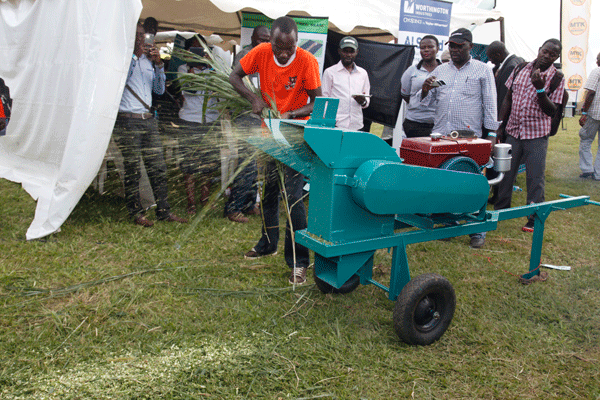Prime
Lessons on making silage to survive frequent dry spells

An agronomist demonstrates how to chop napier grass. PHOTO/RACHEL MABALA
What you need to know:
- Silage will be ready for feeding to cows in 30 to 40 days. To feed, open the pit and remove silage enough for feeding each day then cover again to reduce air getting in.
Josephine is a dairy farmer and trainer in animal production. After years of working with various agricultural organisations, the livestock extension specialist who holds a Master’s degree in climate change studies, returned home to farm and work with dairy farmers, particularly training them on making quality silage as one of the ways to mitigate the effects of the frequent dry spells. Seeds of Gold caught up with her during one of her trainings on silage-making.
Quality
Josephine says making quality silage starts with good timing of the rains, then buying quality seeds – for instance for maize if one is using the fodder. Besides maize, one can also farm Napier grass, sorghum or normal grasses for making silage.
“The crop should be able to reach the appropriate stage in a short time. In the case of maize, it should be harvested at the milk stage (five months) when proteins are sufficient.”
The seeds should be planted in well-tilled land, in a spacing of 60 centimetres between the rows, she offers. “Good management of the crops produces enough silage during harvesting even when planted in a small area.”
How to make silage
From an acre, one can produce 40-50 tonnes of silage, she says. “If a farmer keeps three cows, they need about 30 tonnes of silage to last them throughout the year.” One can use a tractor or machetes to harvest the maize crop, which is then chopped into tiny pieces of about two-inches using a chaff-cutter or machete. Three workers are enough to prepare one tonne of silage, says Josephine. Thereafter, the produce is spread on a polythene sheet for compaction.
One can stamp the chopped pieces or use a drum filled with water to compact them to remove oxygen to curb rotting. Once compacted, molasses is then added to aid in fermentation as one checks the sugar content. Josephine notes silage can be preserved in pit silos (underground) or above the ground. According to her, above the ground silos are more effective when feeding livestock.
“Pit silos can be a bit harder to access. One should get enough silage to cater for several feeding to avoid opening the storage facility every now and then, which can lead to rotting or contamination,” she says, adding the feed is ready after about a month.
Rotting also happens when the silos are not covered well, the silage was not compacted accordingly or bigger sizes of the maize crop were cut, which allows oxygen to get in. According to her, silage is more advantageous since it is easy to feed animals and enables one to have plenty of food particularly during the dry season. “Silage is rarely attacked by rodents. Only ants invade it and this can be controlled early through spraying when making the feed,” says Josephine, adding that one should avoid making silage on a flat area to prevent rain water from lodging at the storage point. According to her, silage should not be offered to the animals alone, but with dry matter such as hay or fodders for examplelucerne. A cow is offered silage depending on its body weight. Normally, it is three percent of its body weight, she explains.
Energy needs
Josephine says silage is a source of energy that animals need. It offers 75 percent of the energy needs of a dairy cow while the other comes from feeds such as lucerne and hay to complete the ration and increase milk production. “When silage, hay and lucerne are used well, they minimise the use of commercial feeds like dairy meal. Good animals can produce sufficient milk for 10 consecutive months at an average of 25 to 30 kilogrammes per day of silage for every cow,” says Josephine.
Besides quality feeds, the animals also need clean water ad libitum and mineral salt every day. “When they are fed well, the weight of each animal goes up to 600 kilogrammes (Friesian), 450 kilogrammes (Aryshire) and 350 kilogrammes (Jersey) at about 39 months especially in intensive farming,” says Josephine, however adding that local farmers fail to attain this weight due to lack of good management.
Energy
Silage is a source of energy that animals need. It offers 75 percent of the energy needs of a dairy cow while the other comes from feeds such as lucerne and hay to complete the ration and increase milk production.




